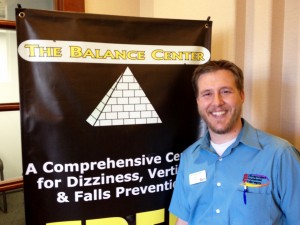
FEATURE — Having a fall can be a scary and traumatic event and, in many cases, falls can lead to serious injury and possibly death. At times, a previous fall can cause people to avoid regular activity simply out of fear.

Most often when thinking about balance or dizziness issues we think of the vestibular system, or inner ear, but in many instances there are other factors at work leading us to feel unsteady on our feet, such as peripheral neuropathy.
The brain relies on feedback from many sources in order to keep us on our feet as we move throughout the day.
The three main sources are: our vision; the vestibular, or inner ear, system; and our somatosensory system, or sensation/proprioception. These systems relay information to our central nervous system, that is, to our brain and spinal cord, and then that information is sent back to our body to keep us stable and to prepare for movement.
An example of this is walking alongside a pool during the summer. We see water on the ground and our experience tells us this could be slippery. As we step into the water and our foot begins to slide, the nerves throughout our legs are stretched and stimulated. This information is quickly sent to our central nervous system, processed, and returned to the muscles throughout our spine and legs. We then correct our footing and can proceed without falling to the ground.
Peripheral neuropathy not only causes many uncomfortable symptoms of pain, burning, tingling, and/or numbness, but it can also delay how quickly the nerves respond, slowing the response to our central nervous system and also to the muscles throughout our legs and body. This then increases our risk of falls and further injury.
Physical therapy can be a great asset to decreasing the risk of falls, despite this terrible disease. Testing can be performed to assess flexibility, strength, sensation, equilibrium, and motor responses.
Exercises designed to increase balance, strength, and flexibility have been shown in many studies to decrease the risk of falls and how a person walks despite their neuropathy.
St. George is a wonderful community and has the professionals and equipment to serve those suffering with balance problems from peripheral neuropathy. There is no better time than the present to improve our balance and decrease the fear of receiving an injury related to a fall.
Physical therapists utilize other systems and treatments to to improve nerve function that is lost with peripheral neuropathy, such as the trademarked ReBuilder system. This modality can act like a “pacemaker for the nerves” helping to restore normal nerve function to damaged nerves. This has been seen to not only decrease the symptoms associated with the disease, but also to improve the motor response during balance testing.

Written by Ben Johnson for St. George Health & Wellness Magazine and St. George News.
Ben Johnson is a physical therapist with Advanced Physical Therapy in St. George. He was raised in Mesquite, Nevada. He graduated from Dixie State College and Southern Utah University, and returned to Southern Utah after obtaining his doctorate in physical therapy from Pacific University in Forrest Grove, Oregon. He currently resides in St. George with his wife and two daughters.
Resources
Related posts
- Preventing falls; hearing, balance
- Research links hearing loss to dementia; free consultation
- Can diabetes cause hearing loss?
- Conventional joins ancient for holistic healing at East West Health
Email: [email protected]
Twitter: @STGnews
Copyright St. George News, SaintGeorgeUtah.com LLC, 2014, all rights reserved.